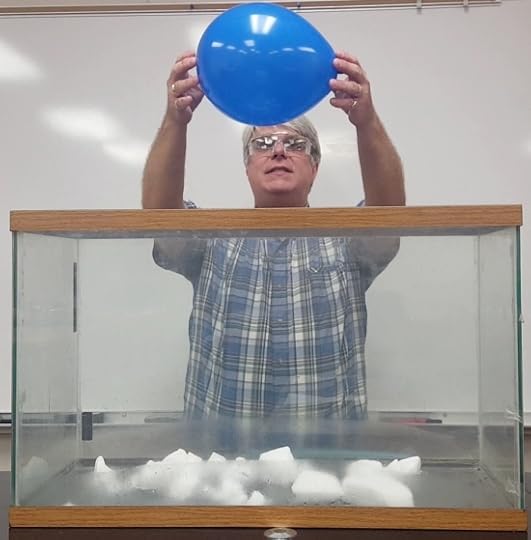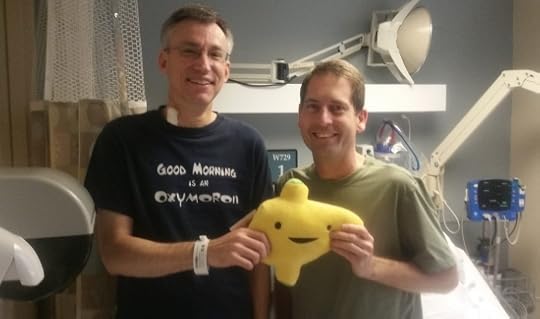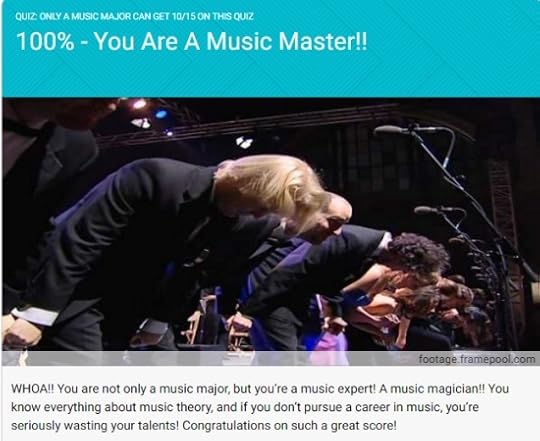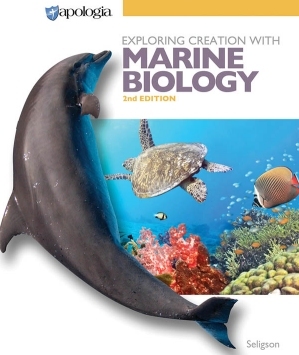Jay L. Wile's Blog, page 30
August 3, 2017
When People Don’t Believe in God, They Will Believe Anything!

Some people actually think it is possible that we are living in a computer simulation.
(click for credit)
Malcolm Muggeridge, the British journalist who was largely responsible for bringing Mother Teresa to the world’s attention, once said:
One of the peculiar sins of the twentieth century which we’ve developed to a very high level is the sin of credulity. It has been said that when human beings stop believing in God they believe in nothing. The truth is much worse: they believe in anything.
(Malcolm Muggeridge and Christopher Ralling, Muggeridge Through the Microphone, British Broadcasting Corporation, 1967, p. 44)
I couldn’t help but think of that quote when a student asked me to read Scientific American’s article entitled, “Are We Living in a Computer Simulation?”
Apparently, that question was the topic of a debate held at the American Museum of Natural History back in 2016. The debate was moderated by serial spreader of falsehoods Dr. Neil deGrasse Tyson, who is responsible for one historian asking if it’s okay to lie about history, as long as the lies support a good cause.
According to the article, Dr. Tyson made the evidence-free speculation that there is a 50/50 chance we are, indeed, living in a computer simulation. Why? Because as Muggeridge suggested 50 years ago, when you give up belief in God, you must believe in all sorts of wild ideas in order to make sense of the universe around you.
For example, the article points out that we live in a world governed by mathematics. For many scientists, that’s a real mystery. After all, according to these scientists, mathematics is just a construct invented by people. Why in the world would this construct describe the natural world so perfectly? Of course, for the scientist who believes in God, this isn’t a problem at all. Galileo explained this fact nearly 400 years ago:
[The universe] cannot be read until we have learnt the language and become familiar with the characters in which it is written. It is written in mathematical language, and the letters are triangles, circles and other geometrical figures, without which means it is humanly impossible to comprehend a single word.
In other words, mathematics wasn’t invented by people. It was discovered by them. It is part of the language in which God wrote His creation. As soon as you reject the existence of a Creator, however, you have to come up with some reason as to why mathematics describes nature so well. Proposing that we are part of a computer simulation is one way to explain it!
Of course, there’s more to it than just mathematics. In the end, most honest scientists admit that there is a lot of design evident in the universe. If you refuse to believe in a Designer, you have to come up with some other explanation. One possibility is that we are just incredibly lucky. There is no design, but in an amazing series of astoundingly unlikely events, random processes produced a universe that just appears to be the result of design. Of course, that requires a person to ignore most of what we know about statistics, but if you really, really don’t want to believe in a Creator, you can probably ignore inconvenient details like that.
Another way an atheist can try to deal with the design we see in the universe is to come up with some other designer. That’s where the computer simulation idea comes from. If we are living in a computer simulation, our designer is just some advanced computer programmer. For some who don’t want to believe in God, this is a palatable alternative.
I, for one, think there is a much more effective explanation for the exquisite design you see in nature. Robert Boyle, the founder of modern chemistry, wrote it more than 350 years ago:
…when, in a word, by the help of anatomical knives, and the light of chymical furnaces, I study the book of nature, and consult the glosses of Aristotle, Epicurus, Paracelsus, Harvey, Helmont, and other learned expositors of that instructive volume: I find myself oftentimes reduced to exclaim with the Psalmist, How manifold are Thy works, O Lord? in wisdom hast Thou made them all!
(Thomas Birch. The Works of the Honourable Robert Boyle, Volume 1. London 1772. p. 262.)
July 31, 2017
Exploring Creation with Marine Biology, 2nd Edition
The cover of Exploring Creation with Marine Biology, Second Edition
About 12 years ago, Sherri Seligson published a course entitled, Exploring Creation with Marine Biology. It quickly garnered rave reviews among homeschooling families. Over those 12 years, I have spoken to many, many high school students who have called it their favorite course, and I can remember at least four of them who said that they planned to study marine biology at university specifically because the course had given them a love for the subject. Such reviews have never come as a surprise to me, because Seligson has the “perfect storm” of characteristics for writing an excellent marine biology course for homeschoolers.First and foremost, she knows her subject. She has a degree in marine biology and was the aquarist of the Living Seas aquarium at Epcot Center for four years. Based on her work there, she was able to publish original research on shark behavior in captivity. Second, she has a real passion for the subject. Just ask her a question about marine science. Her eyes will light up, she will smile, and she will enthusiastically answer your question, along with a dozen other related questions that you hadn’t thought to ask. She is also an excellent communicator, being able to adjust the way she discusses a subject so as to meet the needs of the listener. Finally, she is a homeschooling mother, having educated four amazing children who are now adults. Is it any wonder that she could write a course on marine biology that would become so beloved in the homeschooling community?
However, 12 years is a long time for a biology course to be around. Our understanding of the natural world changes, and sometimes, those changes are substantial. As a result, science courses need to be updated from time to time. So far, the publisher of Exploring Creation with Marine Biology has been “hit and miss” with its updates. A few years ago, the publisher updated its Human Anatomy and Physiology course, making it significantly better than the previous version. The publisher then updated its chemistry course, with disastrous results.
I am happy to report that the publisher is now “two for three,” having produced an excellent update to this already fantastic course.
The new course covers the same content as the old course, starting with the physical aspects of the ocean environment. It then moves on to an overview of the organisms found in marine environments, discussing the characteristics of the major kinds of life found in the seas. It then brings all those facts together in discussions of the various ecological zones of the seas. It ends with how people are affecting these organisms and their environments.
Like the previous edition, there are several experiments woven into the course. Students dissect certain marine animals, explore various physical and chemical processes relevant to marine life, observe microscopic creatures, and do some activities that help illustrate concepts that would otherwise be difficult to grasp. Most of the experiments are the same as the ones found in the previous edition, but there are some new ones.
For example, instead of doing an experiment about how water expands when it freezes (as was the case in the previous edition), students now use household items to help them visualize certain types of tectonic plate movements. Instead of using balloons and socks to understand how roundworms move, students now use balloons and straws to learn the difference between two common digestive systems in marine environments. The best experiment addition, however, is the one on dolphin echolocation. Using household items, students are able to understand how an animal like a dolphin can use sound to sense what is in its environment.
This brings up an important point. As was the case with the previous edition, the experiments come in three types: household-item experiments, dissection experiments, and microscope experiments. Everyone can do the household-item experiments. Special kits need to be purchased to do the other types of experiments, however. Since biology is a prerequisite for this course, you might have some of the things already (like dissection tools and a microscope), but you will still need to purchase some new things in order to do all the experiments in this course (like the animals you will dissect and prepared slides for the microscope).
Of course, the most important issue in my mind is the updated information in the course. In some cases, the new information is based on recent scientific studies. The new edition, for example, discusses the genetics of creatures that live near hydrothermal vents at the bottom of the ocean. That information simply wasn’t available when the previous edition was published. In the same way, a discussion of how icebergs affect plankton in the ocean is the result of information that has come to light since the previous edition was published.
Other added information is not new, but it increases the depth of the course. For example, a discussion of how fishes (as explained in the book, that’s the proper term) deal with water seeping into or out of their bodies has been added. That information was available when the previous edition was published, but it wasn’t included in the previous edition. Nevertheless, it fits seamlessly in the discussion, and it is fascinating. It includes some information that I didn’t know, despite the fact that I have specifically studied that topic in what I thought was some detail.
So in then end, I find this to be a better course than the previous edition. It contains a few better experiments, some new information, and a bit more depth than the previous edition. However, since the order of topics hasn’t been changed, I do think that students in a group setting could use both editions and still work together. It would be good for the students to do the experiments in the new edition, and it would be best if students could “compare notes” so that those with the older edition can benefit from the updated information in the newer edition. However, if the cost of the course isn’t a burden, I strongly encourage you to purchase the new edition (along with its solutions manual), even if you have the older one.
There are several additional things that are sold with the course. There is a course notebook, which I do not recommend. At this age, students should be comfortable keeping their own notes in their own format. There is an audio book for the course, which can be good for some students, especially auditory learners. There is also an instructional DVD that goes with the course. I have not reviewed that DVD, so I can’t discuss it in detail. I would simply point out that the old edition received its rave reviews and became popular among homeschoolers without the instructional DVD. Thus, a student doesn’t need it to understand and love the course. At the same time, however, Seligson is an excellent communicator with a passion for her subject, so I am sure that much of the DVD is incredibly interesting. I guess the issue is whether or not the price is a burden.
July 27, 2017
When Richard Dawkins Notices Your Inconsistency, You Have a Problem!
Dr. Richard Dawkins in 2010
(click for credit)
If you haven’t heard the news yet, Dr. Dawkins was scheduled to read from his new book, Science in the Soul, at a church (ironic, isn’t it?) in Berkeley, California. The event was sponsored by a local radio station, KPFA. However, the radio station got cold feet and cancelled the event. Why? According to the statement they sent to ticket holders:
We had booked this event based entirely on his excellent new book on science, when we didn’t know he had offended and hurt – in his tweets and other comments on Islam, so many people. KPFA does not endorse hurtful speech. While KPFA emphatically supports serious free speech, we do not support abusive speech. We apologize for not having had broader knowledge of Dawkins views much earlier.
I am not sure why the people at the radio station think words that “offended and hurt” constitute “abusive speech.” It seems to me that a lot of statements can offend and hurt people but not be abusive. If I say, “Pedophilia is wrong and should be punished severely,” I am sure to offend some pedophiles out there. However, that statement can hardly be considered abusive. In the same way, Dr. Dawkins has said some terrible things about Islam, but I can’t remember reading anything of his that I thought was even remotely abusive to the people who follow Islam.
Sure, Dawkins has called Islam “one of the great evils in the world.” But is that abusive speech? I don’t think so. Now, of course, maybe I don’t think so because I don’t follow Islam. However, I have read and heard similar thoughts about some things that I hold dear. For example, Dr. Lawrence Krauss said:
Well, I’ve recently, in the United States, just stated that teaching creationism is child abuse and I think it is.
Such a statement clearly offends me, since I think a creationist education is the best science education a person can have (see here and here, for example). Indeed, since I write award-winning science texts designed to give children a creationist education, Dr. Krauss seems to be saying that I am facilitating child abuse. While I find such an idea incredibly offensive, I don’t consider it abusive. I just consider it ignorant.
While I obviously think both Dr. Krauss and Dr. Dawkins would be more persuasive if they moderated their tone, I don’t think they should be shut down because they make offensive statements. I am sure that some of my creationist ideas are offensive to certain people. I don’t think I should be shut down because of them. Indeed, the very Gospel of Jesus Christ is offensive to some people. After all, it states that everyone is a sinner and in need of a savior. For someone who is proud of his moral lifestyle, that can be very offensive. We shouldn’t stop preaching the Gospel simply because it offends some people!
So despite my initial reaction, I am not happy that KPFA shut down Dr. Dawkins. If we are to truly have open, honest exchanges of ideas, we are going to offend people. That’s just the way it is. I want open, honest exchanges, so I am willing to be offended.
What I find most interesting about this situation, however, is a statement Dr. Dawkins wrote after the event was cancelled. In it, he makes much the same argument that I do: offensive speech isn’t abusive speech. Then he writes:
I am known as a frequent critic of Christianity and have never been de-platformed for that. Why do you give Islam a free pass? Why is it fine to criticise Christianity but not Islam?
That’s an excellent question. I personally don’t think Dr. Dawkins is very good with logic and reasoning. However, in this case, he spotted a deep inconsistency in KPFA’s actions. Somehow, KPFA has no problem with him denigrating Christianity. However, they do have a problem with him denigrating Islam.
When your inconsistency is big enough for Dr. Dawkins to notice, you’ve got a real problem!
July 24, 2017
Two Videos About Density

I have been making some videos for the online courses I will be teaching this coming academic year. There will be more to come, but I won’t be blogging about every one of them. I do want to share two of them, however, because they are both very interesting. The first is about things floating in water. Did you know that some bowling balls actually float in water?
The same kind of reasoning used in that demonstration can be used to make a balloon full of air float:
I have done variations of the first demonstration several times, and the Coke/Diet Coke part is from an experiment the students do in their kitchen sink in my elementary course, Science in the Beginning. I had never done the second demonstration before, and I was surprised at how well it worked.
As I said, I won’t be blogging about every video. If you want to see them all, visit my publishers’s YouTube channel. I will be making several more over the course of the next year, so if you like them, you might want to subscribe to the channel.
July 20, 2017
A Test to Determine Whether or Not We Have a Creator

The prevalence of junk DNA is a strong indicator of creation or evolution.
I have always said that evolution requires the presence of a large amount of junk DNA. Not only does it make sense that the “trial and error” nature of random mutations acted on by natural selection would produce a large amount of garbled nonsense in the genome, evolution simulations like Avida require a very large percentage of the virtual genome to be junk in order to get any evolution. A few months ago, I discussed a piece by Salvador Cordova that seemed to make the case even more strongly. However, it was based on the work of Dr. Dan Graur, which I had not read. Thus, I couldn’t evaluate it in a detailed fashion. That has changed.Just recently, a paper by Dr. Graur was published in Genome Biology and Evolution. In it, he makes his argument in a detailed, mathematical way. Having read his paper, I can now see why he made the following statement:
If ENCODE is right, then evolution is wrong.
If you don’t recognize the word “ENCODE,” it refers to a huge scientific initiative that is designed to determine what portions of the human genome are actually used by the various cell types that exist throughout the human lifespan. Their landmark publications in 2012 came to the conclusion that at least 80% of the human genome is functional. Dr. Graur says that if their conclusion is right, then there is no possible way we could have been the product of naturalistic evolutionary processes. When I read his argument as discussed by Salvador Cordova, I was a bit skeptical. However, now that I have read his paper, I am inclined to agree.
Graur’s argument hinges on the idea that natural selection has to “weed out” harmful mutations that are bound to occur from time to time. If harmful mutations are allowed to accumulate in the genome, the results can be devastating to a population. As a result, natural selection not only tends to allow beneficial mutations to survive and be passed on to future generations, it also does not allow harmful mutations to survive and be passed on. Dr. John Sanford and Dr. Robert Carter have already shown that for at least one virus, natural selection is pretty terrible at the latter, but for now, let’s assume it works as well as evolutionists claim that it does.
Dr. Graur makes the obvious point that the larger the percentage of functional DNA in a genome, the more likely it is for a random mutation to be harmful. So for a given mutation rate, the higher the percentage of functional DNA, the larger the number of harmful mutations. The larger the number of harmful mutations, the less likely it is to have a child who doesn’t carry at least one harmful mutation. As a result, more children have to be born so that some of them have no harmful mutations. Those children are the ones natural selection will preserve.
He then makes a mathematical model that tries to determine how many children must be born to each set of parents given a specific percentage of functional DNA in the human genome. He uses a range of mutation rates that come from the literature, and he uses reasonable assumptions (from an evolutionary point of view) regarding natural selection. He comes to the conclusion that given reasonable assumptions, the percentage of functional human DNA is 10-15%. Given the most unrealistic assumptions, it cannot be more than 25%.
He then goes on to evaluate the ENCODE conclusion that at least 80% of the genome is functional. According to his model:
By using the lower bound for the deleterious mutation rate…For 80% of the human genome to be functional, each couple in the world would have to beget on average 15 children and all but two would have to die or fail to reproduce. If we use the upper bound for the deleterious mutation rate…the number of children that each couple would have to have to maintain a constant population size would exceed the number of stars in the visible universe by ten orders of magnitude.
Obviously, then, if ENCODE is right, evolution is wrong.
Now I have to add a couple of caveats here. First, his model is heavily dependent on the mutation rate assumption, and one can make a lot of arguments to suggest that it was lower in the past. Thus, using current measurements of mutation rates might not be the best thing to do. In addition, he defines “function” very specifically. He says that a segment of DNA is functional if there is at least one possible mutation in that segment that would result in some harm to the organism. While I find it unlikely, I suppose it’s possible that some functional sections of DNA are completely immune to the effects of mutation.
However, what I can say is this: It seems that given a few assumptions that are commonly made in evolutionary circles (measured mutation rates are reasonably indicative of past mutation rates, any truly functional region of DNA can be harmed by at least one kind of mutation, mutations are truly random, the human genome has been around for at least a couple of hundred thousand years, etc.), then if the ENCODE conclusion is right, evolution cannot possibly work.
So in the end, it seems to me that this provides an excellent test between the naturalistic evolutionary view and the view that we have a Creator. If the naturalistic evolutionary view is correct, we should eventually find out that ENCODE is wrong, and only a tiny percentage of the genome is functional. If ENCODE is right, then the naturalistic evolutionary view is wrong and we have a Creator. I honestly think that the validity of the ENCODE conclusion will be confirmed within the next 20 years, so this is really an exciting time to be a creationist!
I do want to end with one more caveat. I seriously doubt that any hard-core evolutionist (including Dr. Graur) will give up his or her fervently-held belief in a naturalistic origin myth once it is confirmed that ENCODE is correct. Most likely, they will do what evolutionists have done time and time again. When an evolutionary prediction is falsified (see here and here), they will “explain around” the data in order to preserve their faith in naturalistic processes. Nevertheless, as more creationist predictions turn out to be correct (like these), more truth-seeking scientists will realize that we have a Creator.
July 17, 2017
Boiling a Liquid In Order to Freeze It

I have been putting together some videos for the online classes that I will be teaching in the fall, and I just posted this one to YouTube. It demonstrates the true definition of boiling point, and it shows how you can freeze a liquid by boiling it. It also demonstrates what the triple point is.
July 12, 2017
When Someone Really Believes The Words of Jesus

The man who owns the company that publishes my new books (left) and the man to whom he donated part of his liver (right).
When some Jewish leaders were trying to pull a “gotcha” moment on the Son of God, the following exchange took place between Jesus and a Pharisee:
One of them, a lawyer, asked Him a question, testing Him, “Teacher, which is the great commandment in the Law?” And He said to him, “‘You shall love the Lord your God with all your heart, and with all your soul, and with all your mind.’ This is the great and foremost commandment. The second is like it, ‘You shall love your neighbor as yourself.’ On these two commandments depend the whole Law and the Prophets.” (Matthew 22:35-40)
There it is, straight from God Incarnate. The two most important things you need to do in life is love God and love your neighbor. If I am being completely honest here, I don’t know many Christians who actually do both. I most certainly don’t. I try, but I tend to fail pretty miserably, especially at the second one.
There are, however, a precious few Christians I have met who honestly believe the words of Jesus and live their lives according to the two greatest commandments. One of them is pictured above, on the left. His name is Jon, and he owns Berean Builders, the company that publishes my award-winning elementary courses and my new chemistry course.
I met Jon back when I was a Programmer/Analyst for a medical firm called “Pathologists Associated” (PA). We needed a computer programmer who understood this “new” thing called the internet, and we interviewed several candidates. Jon had no formal credentials in computer programming, but he had convinced the company he was working for at the time to computerize its inventory. He chose the system that would be used, and in a short time, he taught himself how to program it. Not long after, he became so accomplished that the company that made the system started giving him programming jobs to do on the side.
Some of the people on the selection committee didn’t like the fact that he had no formal credentials. However, his accomplishments demonstrated his ability, and we hired him. It didn’t take long for him to rise to the position of Vice President and CIO. That’s just how talented he is. As a side note, I have to say that in my limited experience, the best computer programmers with whom I have worked have no formal training in computers. As far as I am concerned, teaching yourself how to program is the best way to learn computers.
Not only is Jon incredibly talented, he loves the Lord. He is one of those people who is at church whenever the doors are open. He leads singing, is on several committees, etc., etc. He is a deeply spiritual man who knows his Bible better than most Christians, certainly better than me. I know that because of our sometimes spirited (but always congenial) theological discussions. He takes the greatest commandment very seriously.
Unlike most of us, however, he also takes the second-greatest commandment just as seriously. I can cite many day-to-day examples that demonstrate this, such as helping elderly neighbors, generously giving his money to those less fortunate, etc. However, the one that inspired this blog post is pictured above. He voluntarily went under the knife to donate a portion of his liver to another person.
I realize, of course, that there are others who do such donations. However, the details of this donation are what demonstrate Jon’s commitment to the second-greatest commandment. First, he had to travel from Indiana to Pittsburgh, Pennsylvania. That’s where the donation took place. This meant that he and his wife would be staying away from home for nearly two weeks. He spent most of that time in the hospital, of course, but his wife was in a hotel. This was done mostly at their own expense.
The second part is more important. When he first told me that he might be donating a portion of his liver, I asked, “To whom?” He gave me the person’s name. I asked, “Who is that?” He told me that we had worked with him back at PA. I couldn’t remember him at all. I found out that he had left PA in 2008 and had moved to Pittsburgh. I asked Jon if they had kept in touch after he left. Jon said no. However, another co-worker with whom Jon has kept in touch is friends with him on Facebook, and that’s how Jon had learned about this man’s need for a liver. I then asked Jon if he was good friends with this man while he was working at PA. In typical Jon style, he replied with something like, “Well, I didn’t dislike him.”
So what does it mean to “love your neighbor as yourself”? I think this is a pretty good illustration. Willingly limit your diet for several weeks before and after undergoing full-blown thoracic surgery that will remove a portion of the largest internal organ in your body. Willingly do this knowing that it will land you in the Intensive Care Unit for several days, even if everything goes really well. Willingly spend the next several weeks in limited activity as your largest internal organ grows back to its proper size. And willingly do this for a man you hardly know and haven’t seen in nearly 10 years.
Here is an edited version of what the recipient of Jon’s donation said on his Facebook page:
I received a welcomed phone call late last week letting me know that a living-donor had been evaluated and approved for me. My transplant surgery is scheduled for the end of June. My family and I are overjoyed.
I didn’t know until just the other day the identity of the donor. Those of you who know Jon…won’t be surprised that he volunteered to be evaluated and has agreed to be the donor…
In my early IT career…I worked with and then for Jon as he became the CIO of our medical laboratory. He is a man of solid faith, who lives his deeply held values every day. His humility, generosity, humor, intelligence and willingness to help others always impressed me. I had incredible respect for Jon during the years I worked with him.
He thought he was rid of me in 2008 when…I moved away to Pittsburgh. But, like a bad penny, I popped back into his life 9 years later. Little did we know that someday he’d expand his generosity to include a life-saving organ donation.
It may sound a little odd to say this, but I am truly honored to be the recipient of Jon’s gift. I already told him there’s no adequate way to thank him, and I can never reciprocate to the level of his sacrifice. What a humbling experience this has been, and continues to be, for me.
Imagine what this world would be like if everyone took the two greatest commandments as seriously as Jon.
July 10, 2017
A Perfect Example of Critical Thinking

The picture associated with the Facebook Quiz discussed in the post.
One of the talks I give at a lot of homeschooling conventions is entitled, “Teaching Critical Thinking.” It is a fairly popular talk, and I enjoy giving it. Of course, one of the best ways to illustrate critical thinking is to give an example of someone actually doing it. I recently ran across just such an example, so I thought I would write about it and incorporate it into that talk.
I play the electronic keyboard (and occasionally the piano) at church. While there are much, much, much better pianists than me, I enjoy playing, and some members of the congregation like to watch me while I do it, because I tend to get lost in the music, sometimes almost “dancing” at my keyboard. Indeed, a good friend once called me a “musician,” and I promptly corrected him. I told him that I am a dancer who uses a keyboard as a prop. He agreed.
In any event, because some people think of me as a musician, I often get tagged in Facebook posts that deal with music. Such was the case a few days ago. A good friend of mine tagged me when she posted the Facebook quiz pictured above. As you can see, the quiz says, “Only A Music Major Can Get 10/15 On This Quiz.” My friend was happy, because she had scored 100%. At first, I didn’t take the quiz at all, because my knowledge of music theory is incredibly weak. However, my friend tagged several others, and many of them took the quiz. Nine of them posted their results, and all of them got 100%.
That’s when one teen’s critical thinking skills kicked in.
The teen to whom I refer is named Elli, and she is an incredibly talented musician who usually plays the piano for our church. I sit behind her, playing an electric keyboard to add a bit of an “orchestral” feel to the worship music. She is not only an excellent pianist (and singer), but she also knows music theory really well. Whenever I am confused by the chord progressions in a song, I ask her, and she patiently explains them to me. It is an absolute joy to work with her.
In any event, after the nine people posted their perfect scores, she posted this:
Not to burst everyone’s bubble, but I also got a 100%, and then grew suspicious. I took the test again and purposely missed 50% of the questions and low and behold… I got a 100%.
I’m sure you all are very smart and musically educated people, but this is your comedic warning to not quit your day jobs and become music majors.
This is a perfect example of what it means to think critically. Elli read that nine people got 100% on a quiz that contained some aspects of music most people don’t worry about, such as how many sharps are in the key of F minor (the answer is none – it has four flats). She grew suspicious that there were no reports of people getting less than 100%. As a result, she decided to “test the test.” Knowing all the answers, she took the test again, purposely missing several. She still got 100%, indicating that the test was faulty. I repeated her process, getting 100% twice, even though several of my answers were different in the second attempt.

Now this doesn’t surprise me. These days, “self esteem” is valued more highly than truth in many circles. As a result, some groups don’t care if people learn anything. They just want people to feel good about themselves. As a result, they don’t correct falsehoods. They just want everyone to think they are experts about everything. As an educator, that really, really bothers me. Unfortunately, I see it happening more and more in many educational settings.
So the obvious “take home” message here is that you shouldn’t believe the results of Facebook quizzes. The more important message, however, is that you should start thinking like Elli. When you encounter results that seem wrong, question the method used to produce those results. That’s one of the hallmarks of critical thinking.
July 6, 2017
Homeschooling and Socialization

Homeschooled children are better socialized than those in public and private school. (click for credit)
When I first started working with homeschoolers, lots of people were concerned about socialization. They wondered how children would “learn” to get along with other children and navigate difficult social settings without being in school. Even before I started researching the matter, I thought the concern was unfounded. After all, school is probably the most artificial social setting a child will ever experience. When are adults ever cloistered away in ghettos, surrounded by people who are the same age? Never. Thus, the idea that students can learn good socialization at school always seemed nonsensical to me.
Nevertheless, people did express concern, so I looked through the academic literature. Even back in the 1990s, there was a wealth of research available on the socialization of homeschoolers. Not surprisingly, the research showed that homeschoolers were better socialized than their publicly- and privately-schooled peers. Perhaps the most interesting study done back then was a Ph.D. thesis by Larry Shyers. In his study, he filmed children from public, private, and home schools in free and structured play. The behaviors of those students were then analyzed by clinical psychologists who didn’t know the schooling backgrounds of any of the children. When Shyers compared the analyses of the homeschooled children to those of the other children, he saw that in nearly all categories of social interaction, the homeschooled children were equivalent to the children from public and private schools. There was only one category in which the homeschooled students scored lower: problem behaviors. As Shyers wrote:
It can be concluded from the results of this study that appropriate social skills can develop apart from formal contact with children other than siblings.
Wow! What a shocker! Children can learn to get along with other people even if they aren’t cloistered away in ghettos, surrounded by people their own age!
Now as I said, even back in the 1990s it was well known that homeschooled students are, on average, better socialized than their peers. Why, then, am I writing about homeschoolers and socialization now? Because someone raised the issue in a Facebook group of which I am a part, and I decided to turn my response into a more detailed blog post.
Let’s start with the academic research, of which there has been a considerable amount. Dr. Richard Medlin, a Professor of psychology at Stetson University, has produced one of the best summaries of this research, which is actually an update of a summary he produced in the year 2000. In his summary, he discusses research done on homeschooling parents’ views about their children’s socialization, the social skills of homeschoolers as measured by standardized assessment tools, emotional and life-satisfaction of homeschooled students as evaluated by the students themselves, the moral and religious views of homeschooled students, and how homeschooled students have adjusted to college or adulthood. He summarizes the results of the studies as follows:
Compared to children attending conventional schools, however, research suggest that [homeschoolers] have higher quality friendships and better relationships with their parents and other adults. They are happy, optimistic, and satisfied with their lives. Their moral reasoning is at least as advanced as that of other children, and they may be more likely to act unselfishly. As adolescents, they have a strong sense of social responsibility and exhibit less emotional turmoil and problem behaviors than their peers. Those who go on to college are socially involved and open to new experiences. Adults who were homeschooled as children are civically engaged and functioning competently in every way measured so far. An alarmist view of homeschooling, therefore, is not supported by empirical research.
While the academic research is important, I have been working with students from public, private, and home schools for most of my career. As a result, I would like to add my personal observations. First and foremost, the reason I work with homeschoolers today is because I experienced homeschool graduates while I was on the chemistry and physics faculty at Ball State University. They impressed me by being better educated than their peers, more mature than their peers, and less likely to get into trouble than their peers.
Once I started working with homeschooling parents and children who were being homeschooled, I continued to be impressed with how well socialized the students are. For example, as a university faculty member, I often visited high schools to speak with students about coming to Ball State University. When I asked for questions, no one would raise a hand, and after class, it was nearly impossible to engage the students in conversation. They just weren’t interested in socializing with someone like me.
When I spoke to student groups at homeschool conventions and asked for questions, hands would shoot up in the air. I even have done a few sessions where all I do is answer homeschooled students’ questions. When students would come to see me at my booth or after a session, talking with them was easy. They were genuinely interested in socializing with me. In fact, I would often have to apologetically tell students that they had to move on, since there was a line of other people waiting to speak with me as well.
Are there socially-awkward homeschooled students? Absolutely. Are their socially-awkward public and private school students? Absolutely. Based on both the academic research and my own personal observations over the past 20+ years, I can say without a doubt that students who are homeschooled are, on average, much better socialized than their peers. If your goal is socialization, then, your best option is homeschooling.
June 26, 2017
Wild Birds and People Work Together in Mozambique

A greater honeyguide bird (click for credit)
In 1586, a Portuguese missionary named João dos Santos began ministering to the people of Mozambique. While his focus was evangelism, he also studied the people and observed the colonization process. His detailed observations were reported in a monograph entitled Ethiopia Oriental, which was published in 1891. One of the interesting things documented in his monograph was the relationship between the people of Mozambique and a native species of bird, now known as the Greater Honeyguide (Indicator indicator). He claims to have seen these people call out to the bird, which then led them to bees’ nests so that they could collect honey.
While many have reported this fascinating interaction since João dos Santos first documented it, detailed studies have been lacking. Dr. Claire Spottiswoode and her colleagues have taken care of that problem, publishing a fascinating study in last year’s Science. They investigated the interaction in depth and found that the people of Mozambique have a specific call that they use, and the birds then respond by guiding them to a bees’ nest. You can hear the call they use by clicking on the audio tool found in this article.
Why would the birds help people find bees’ nests? Because they eat beeswax. João dos Santos figured this out because he saw some of them nibbling on the beeswax candles he had in his chapel. Since their ability to fly allows them to scout a large area in a short amount of time, they know where the bees’ nests are. However, they have a hard time getting to the wax that they want to eat, because the bees defend their nests. Thus, they need help to get to the wax. That’s where the people come in.
They cut down the tree that contains the bees’ nest and then use fire to smoke the bees out. The people collect the honey, and they leave the beeswax behind for the birds. They also take chunks of wax from used honeycombs and set them on beds of leaves to reward the birds for a successful hunt. This is a very interesting example of one of my favorite topics in biology, mutualism (see here, here, here, here, here, here, here, here, and here), which is the process by which individuals from different species work together so that each benefits.
Now, what makes this study unique is the fact that it tests whether or not the bird call used by the people actually attracts the birds. After all, it could be that the birds come to people whenever they hear them, hoping that they want to be led to a bees’ nest. It could also be that the birds just happen to be in the area when people are looking for honey, and the people just follow the birds to the nests to get the honey. Dr. Spottiswoode and her colleagues wanted to find out exactly what is going on.
They followed honey-hunters and played recordings of either the honey-hunters’ call or a native speaking. They found that the people sometimes found bees’ nests without the help of birds, and they also found that sometimes, they would encounter a bird that would lead them to a bees’ nest. However, they found that when they played the specific call the people use, they were twice as likely to find a bird guide, and their odds of finding a bees’ nest increased by more than a factor of three. In addition, the researchers noted that when the people made their specific call, the birds would answer with their own specific call.
In other words, the people and birds are actually communicating! The call that the people make tells any birds in the area that they are looking for honey, and the call that the birds make tells the people that they are willing to guide them to a bees’ nest. As far as I know, this is the first concrete evidence of communication between people and non-domesticated animals.
The next question, of course, is how do the birds know to respond to the call? The people know to make the call because their parents train them to do it. Does the same thing happen with the birds? Dr. Spottiswoode and her colleagues are trying to determine that right now. If I run across any updates, I will let you know!
Jay L. Wile's Blog
- Jay L. Wile's profile
- 31 followers





